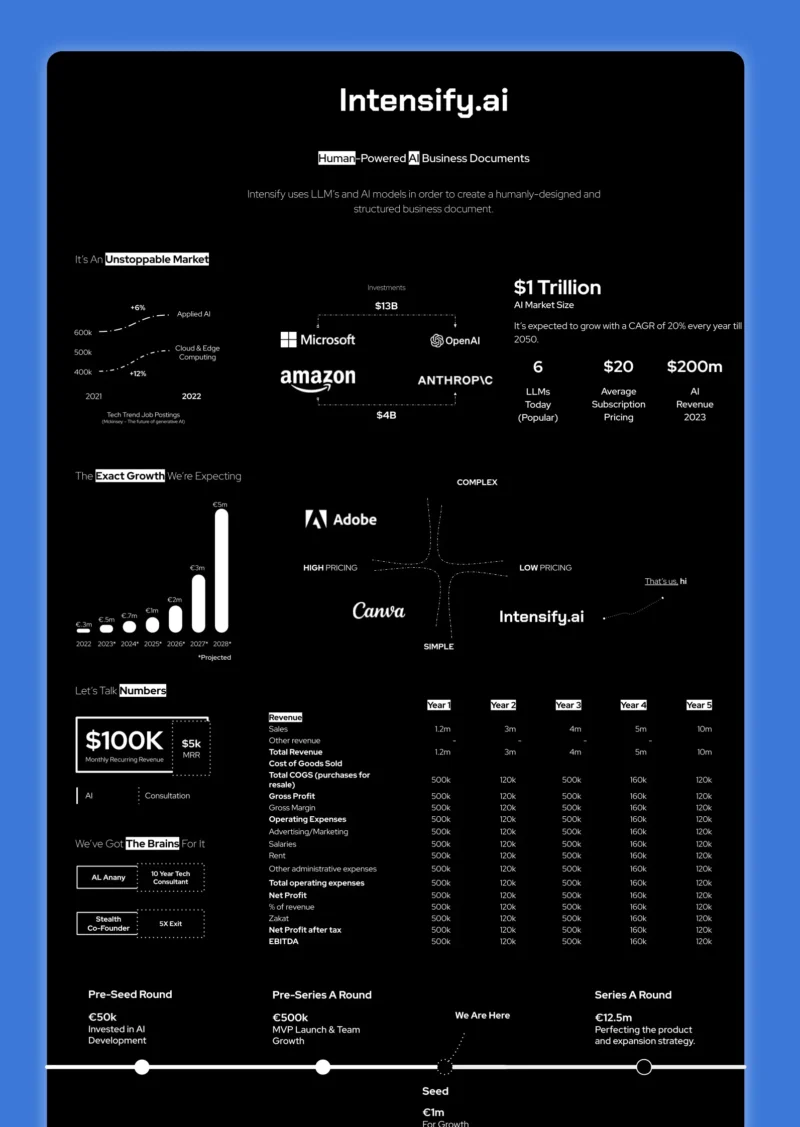YCombinator, the world’s largest accelerator, says ten slides. Sequoia, another huge VC, says 12. Guy Kawasaki, quite the famous figure in the startup world, says 10. Who should you believe? How long should a pitch deck be in our current fast-moving AI age? Let me chip in with my 12 years of experience in the startup world.
The answer to the question lies in the stage of your company.
Pre-Seed – A Short Pitch Deck.
At the pre-seed stage, your primary goal is to grab attention and spark interest fast. Investors are inundated with pitches, so yours needs to stand out while being succinct. Aim for a lean, compelling deck of about 7-10 slides. At this stage, you’re introducing your vision, the problem you’re solving, your solution, and why your team is the one to bet on. Keep it crisp, clear, and compelling. Think of it as your elevator pitch extended into a visual narrative that leaves them wanting more.
A good example of such a deck is the famous Airbnb pitch deck
Post-Traction – A Medium Pitch Deck
Once you’ve got some traction, your pitch deck is your storytelling canvas, but it still needs to be concise. Here, you’re looking at a sweet spot of 10-15 slides. This range gives you enough space to showcase what you’ve achieved—key metrics, user growth, market fit—and what you’re planning next. It’s about building on that initial interest and demonstrating your potential for scale. Investors at this stage want to see momentum, and your deck should reflect that with clarity and confidence.
A great example is the Uber pitch deck (It’s around 25 slides, but that was pitched a long time ago. Nowadays, 15 would do just fine for their product.)
Series A – A Long Pitch Deck
For Series A, you’re in a different league. Investors are not just curious; they’re seriously considering a substantial investment in your company. Here, your pitch deck can extend beyond 30 slides, tailored to answer a crucial question: “What have you achieved with previous investments?” This is your chance to dive deep into details—financials, strategic roadmap, product development, market expansion, and how you stand against competitors. Your narrative needs to be rich, data-driven, and forward-looking, providing a comprehensive view of your business and its trajectory.
A good example of a deck that displays numbers as such is the Fiverr pitch deck. They’re a public company, so not exactly Series A, but you’d expect something similar from a Series A company.
Personalization – Long and Short.
But here’s the kicker: there’s no one-size-fits-all in pitch decks. Personalization is key. Your deck’s length and content should resonate with your product and the interests of your prospective investors.
If an investor is particularly keen, they might appreciate a more detailed exploration of your startup. Hence, it’s wise to prepare a few versions of your pitch deck: a shorter, high-level overview for initial meetings and a longer, detailed version for deep dives. Understanding your audience and tailoring your pitch to their preferences can significantly enhance your chances of making a memorable impact (That’s why I always do extensive investor research before reaching out to them.)
YCombinator, Sequoia, and Guy Kawasaki provide valuable starting points. The best pitch deck length today ultimately depends on your company’s stage and the interests of your audience.
It’s your company’s story, so say it in a way that matters.
Now let me give you a few last tips from my years of operation.
Pitch Deck Tips
Quality beats length.
In today’s fast-paced world, attention spans are shorter than ever. This shift shows that you need a short yet impactful approach to pitch decks.
A single, well-crafted line can make a more significant impact than thirty pages of filler.
The key is to say things that matter. Focus on the essence of your message, ensuring that each slide, each sentence, and every image directly contributes to your overall narrative. Clarity in your proposition and the value you offer is paramount. This approach not only respects the time of your audience but also demonstrates your ability to distill complex ideas into digestible, compelling points.
Every reader is different
Understanding your audience is crucial in tailoring your pitch deck. Every investor has a unique perspective, influenced by their experiences, interests, and investment focus.
Creating a storyboard for your pitch deck is an effective strategy in this customization process. A storyboard can help you visualize and plan the flow of your presentation, ensuring it resonates with each specific investor. This method allows you to weave a narrative that speaks directly to their interests and concerns, thereby increasing the relevance and impact of your pitch.
Here’s a guide on how to create the perfect storyboard.
New Platforms For Pitching
Innovation in pitch deck presentation is evolving. Platforms like Pitch.com, while brilliant, are trying to change the way we pitch graphically. The modern investor often prefers straightforward answers and clear data.
While design is important, it should not overshadow the substance of your pitch. The aim is to facilitate understanding and highlight key points without unnecessary distractions.
Incorporating advanced techniques such as interactive elements or concise, impactful visuals can enhance your pitch, provided they serve to clarify your message and make your data more accessible. But according to experience, they usually don’t and are actually diverting the focus.
Instead of Writing, Go and Do.
A common pitfall in preparing pitch decks is focusing too much on the deck itself rather than the business it represents. Remember, the deck is a tool to showcase your business, not the end goal.
Demonstrating traction is a powerful way to shift the focus back to what truly matters. Traction speaks volumes about your business’s viability and market acceptance.
If you have tangible results, highlight them. This not only validates your business model but also transforms your pitch deck into a compelling, evidence-based narrative. Avoid relying solely on the aesthetics of your presentation; let your business’s achievements speak for themselves.
Most Internet Data are Not Useful.
In an era of information overload, the source of your data becomes as important as the data itself. Credibility is key. Utilize data from reputable sources such as Deloitte or McKinsey, which are known for their rigorous research standards and reputation. This not only lends credibility to your pitch but also reflects well on your diligence and commitment to accuracy.
Avoid sources like Statista or other unverified platforms where the data’s authenticity might be questionable. By anchoring your pitch in reliable data, you provide a solid foundation for your claims, making your case more persuasive.
Let’s summarize for you to remember:
- A pitch deck length depends on the stage of your startup.
- Create versions.
- Focus on quality over length.
- Study your reader.
- Traction beats everything.
- Quality research makes a difference.
That’s all you need at this stage. Now go write an amazing pitch deck!




